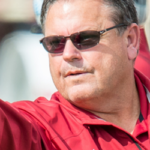 There were books, an ESPN documentary and assorted myths and legends told about “The Junction Boys,” the 27 or so kids who survived Paul “Bear” Bryant’s never-to-be-tried-again football preseason boot camp in the Texas drought and intense heat wave of 1954. It became a story of legend because those kids, like Gene Stallings, went on first to go 1-9 as Aggies in 1954, but then with eventual Heisman Trophy winner John David Crow they would proceed to briefly take over the old Southwest Conference in 1956-57, before Bryant, the Arkansas native, skedaddled to rebuild Alabama, his alma mater, to national dominance.
There were books, an ESPN documentary and assorted myths and legends told about “The Junction Boys,” the 27 or so kids who survived Paul “Bear” Bryant’s never-to-be-tried-again football preseason boot camp in the Texas drought and intense heat wave of 1954. It became a story of legend because those kids, like Gene Stallings, went on first to go 1-9 as Aggies in 1954, but then with eventual Heisman Trophy winner John David Crow they would proceed to briefly take over the old Southwest Conference in 1956-57, before Bryant, the Arkansas native, skedaddled to rebuild Alabama, his alma mater, to national dominance.
While Bryant was making his players endure all kinds of hell in tiny Junction – four buses took the players to that stop-in-the-road and only one was needed for the return trip to College Station 10 days later, Bowden Wyatt had already done similar culling at Arkansas over the previous year. He didn’t have a “Junction.” His boot camp was on The Hill, where he weeded out the haves from the have nots. His first Razorback team went 3-7, which wowed no one and fit right in with the level of production seen in the previous three years under the overwhelmed Otis Douglas (2-8, 5-5, 2-8, the worst stretch of Razorback football post-WWII).
Wyatt’s 25 Little Pigs that were left by August of 1954 came together as a unit and won the Southwest Conference outright, beat No. 4-ranked Ole Miss 6-0 in Little Rock in the UA’s first program-defining win and represented the league in the Cotton Bowl against then-powerhouse Georgia Tech (who had an offensive coordinator named Frank Broyles). The fans were so enthralled by this turnaround, they reportedly bought Wyatt a new Cadillac, which he then drove off to HIS alma mater to replace Gen. Bob Neyland as his hand-picked successor at Tennessee.
There’s little notoriety about Wyatt’s tearing down and building back of the program he inherited from Otis Douglas, compared with Bryant’s Junction legend. Most of it has been forgotten. Eddie Bradford is one of the last of the 25 Little Pigs left. My friend George Walker, the longtime Pine Bluff banker who died earlier this year, was the sophomore quarterback. The late Buddy Bob Benson threw the magical touchdown pass to Preston Carpenter on the “Powder River play,” a Wyatt offensive creation, that beat Ole Miss and made Arkansas suddenly a national name in college football.
It was back to the boonies, though, for the next three years, as Jack Mitchell could not replicate what Bowden had done, turning in six-win seasons before realizing the job was too much for him and leaving for Kansas. Bryant had become formidable at A&M, and Texas was recommitted to winning again and hired Darrell Royal in 1957 (and he upset Bryant in the regular-season finale that year). The SWC’s private schools were strong then, and often were beating the best from the SEC, ACC and the like.
Of course, it took Frank Broyles to jump after one season at Missouri to take Arkansas to heights now only remembered fondly by the wrinkled lot of fans and sportswriters, of which I number. There will be some nod once again this ball, the 50th anniversary, to that bitter 1969 loss to Texas for the national championship, and somebody will remember that Arkansas actually WON a huge game against then-burgeoning power Nebraska to capture a couple of versions of a national championship in 1964. But none of that will mean much of anything to the thousands of students who show up at Reynolds Razorback Stadium Saturday for the 2019 season opener vs. Portland State, nor will it mean a whole lot to the under-40 crowd, the fans who buy many of the tickets these days.
For them, it’s ancient history, like it almost didn’t happen. Kind of like remembering the days of Bowden Wyatt, reshaping his program and running off the non-committed players.
But what Chad Morris has had to endure and accomplish in the past year rekindles the memory of the Wyatt story. Morris’ 2-10, though called by some as the “worst season in Razorback history” – and, as for win-loss record, it is, but they play 12 games now and not 10 as they did pre-1970) – probably was a lot like Wyatt’s 3-7 first year. Truly, Arkansas was head-and-shoulders worse in talent than every SEC team it played last year, though the Hogs still were in position to upset Ole Miss in the rain in Little Rock. They just couldn’t stop anybody good when they had to. Morris’ team, in talent, was better than three nonconference teams it played, and the Hogs beat two of them, but like the loss to Ole Miss they blew a third game at Colorado State because they couldn’t stop anybody good when they had to.
But, it was obvious to former players who saw Arkansas scrimmage in August last year that the Hogs were at the lowest point they’d seen since the program joined the SEC. Heck, to many they no longer looked like an SEC program. Whether anyone wanted to admit it, there was no SEC-level quarterback on campus. There weren’t many offensive and defensive linemen worthy of wearing an SEC decal on the jersey. Most of the seniors on defense, with the exception perhaps of Dre Greenlaw and surprising standout lineman Armon Watts, had become ingrained with the style and mentality of the previous staff and weren’t going to buy in to the new regime. Before the end of November, they had quit. So had a few on the offensive side.
Morris began his culling before last season, but this is a different era than Junction or the 25 Little Pigs – for you youngsters reading, those days and all the way until the early ‘60s, players went both ways and there were limited substitutions; you could get by with 25 or 27 total players, you just needed 11 good ones and a few backups. One of those starters typically kicked, too. Different game in a way – same game when it came to the fundamentals, blocking and tackling.
Morris couldn’t look half his squad in the eye in the winter and spring of 2018 and tell them to hit the road. He had to manage what he had, recruit hard, get rid of more folks who didn’t buy in after the season, and look for incremental improvement in the off-season program and this past spring.
No one was allowed to wear official Hog workout clothes in the offseason until it was earned, including the coaches. The freshmen who passed up their high school senior springs to enroll early jumped into the fire, and by the Red-White game in early April, it was obvious all of them could play. They were deserving of the recruiting attention.
Of course, there’s not enough of them yet. You can’t bring in unlimited scholarships now like you could in the early 1950s, just 25. The rebuild process is time consuming, and doubly or triply tough in the SEC, where nobody appears to be going backward.
It’s a Sisyphus-like chore to ascend in the SEC Western Division, what with Alabama, LSU, Texas A&M and Auburn committed in every way to contend for national championships. Arkansas’s newest goal under Morris should be to regain the upper hand over the Mississippi schools, something fans could count on during Houston Nutt’s regime. The second goal this year for Morris and his Hogs should be to go 4-0 against one of the less-imposing nonconference slates ever scheduled by the Hogs, starting with FCS Portland State.
Morris and Arkansas, now with two quarterbacks who have competed and won at their previous schools before graduating and transferring to Fayetteville, should feel better about what can be accomplished offensively this fall. The 11 players who were offensive starters at this time a year ago have been replaced – totally unheard of in Razorback history. Now, sure, there were starters at the end of the season who return, but much will be expected in terms of leadership and 100 percent buy-in or commitment (we’re talking about two starting linemen, tackle Colton Jackson and center Ty Clary, and a talented athlete of a tight end in C.J. O’Grady) or Morris needs to waste no time changing those spots out. Already, the receiving corps is improved tenfold with SEC-level talent starting this week in freshmen Trey Knox and Treylon Burks. Fans may finally see what all the fuss was about when senior running back Devwah Whaley decommitted from Georgia to sign with Arkansas four years ago, and Rakeem Boyd’s flashes of brilliance last year should be more frequent this year now that his shoulder has been repaired.
Defense remains a question only because of youth scattered throughout the two-deep lineup, rather than the lack of ability (and speed!) that has been obvious in the past. Coordinator John Chavis is determined to prove the game hasn’t passed him by – while people criticized Arkansas’s defense last season, there still was significant improvement in several key statistics, and this year with an all-senior starting defensive front and more secondary speed, Chavis may be closer to having the skill he’s used to leading. Outside of senior De’jon Harris, though, the linebacker spots and the depth still have to be huge question marks in SEC-level ability, until we see differently.
Morris knows the kicking game can’t go wanting this year; hence, he brought in off-field and on-field help there with the staff. The punting should not be a negative; the place-kicking ought to dependable with senior Connor Limpert. The protection and coverage teams will be manned by better athletes wanting to impress the coaches for more playing time beyond special teams, which should correlate to a higher standard of play than we’ve seen recently.
Morris needs two more recruiting classes like the last one for Arkansas to start thinking about competing week-in and week-out with the upper echelon of the division and this year he needs luck with injuries so that the current lack of depth doesn’t become too obvious. It’s a grind every week, starting with Ole Miss on the road in Week 2. There are road games at Alabama and LSU. Kentucky, another road game in mid-October, shouldn’t be overwhelming in ability but looks like it has a competitive system in place now under Mark Stoops, starting his seventh year. How many would have bet Stoops and Auburn’s Gus Malzahn would be the survivors, among Bret Bielema and Butch Jones, when those four were hired the same season? Stoops, remember, walked into a disaster in Lexington not unlike what Morris inherited last year with the Razorbacks.
For every year post-Bobby Petrino, Arkansas can’t seem to catch a break against Texas A&M, no matter who’s coaching the Aggies. Malzahn, the former Arkansas high school coach who reportedly turned down Arkansas’s overtures of $7 million a year two winters back, seems to enjoy slapping the Hogs around wherever they play (though that hardly is enough for Auburn fans). Who knows what Mississippi State will be like by November, with its self-imposed suspensions in place through the season? Missouri, playing the Hogs in Little Rock on Black Friday, has been the wild card every year; again, like Stoops, who would have figured Barry Odom could have survived, let alone turn the Tigers into a winner, considering where Mizzou stood three years ago, its program obviously in awful shape, trailing the Hogs convincingly at the half at home before rallying for an upset that, at the same time, foretold Bret Bielema’s fall?
Can Arkansas’s pups with their veteran quarterbacks, Ben Hicks and Nick Starkel, bite once or twice against those more-successful-of-late programs and manage a 6-6 regular season, and maybe land a bowl game, good headlines, more excited recruits who sign in late December and early February, and propel this program turnaround? Can Morris maybe get that Bowden Wyatt-like buy-in and shock the world with an almost-unthinkable seven or eight wins, and maybe a program-defining one like Wyatt’s 25 Little Pigs managed against a Top 4 team?
Which then leads to this last, scary thought: Will Arkansas fans then stupidly present Morris a Cadillac as he’s driving off to greener pastures?
That’s one bridge we can wait on crossing.













